Dumortierite quartz is a unique variety of quartz that contains inclusions of dumortierite, a rare aluminum borosilicate mineral. This combination results in a stunning blue to violet-blue coloration within the quartz crystal. It’s a relatively lesser-known gemstone but is highly prized by collectors and enthusiasts for its beautiful color and metaphysical properties.
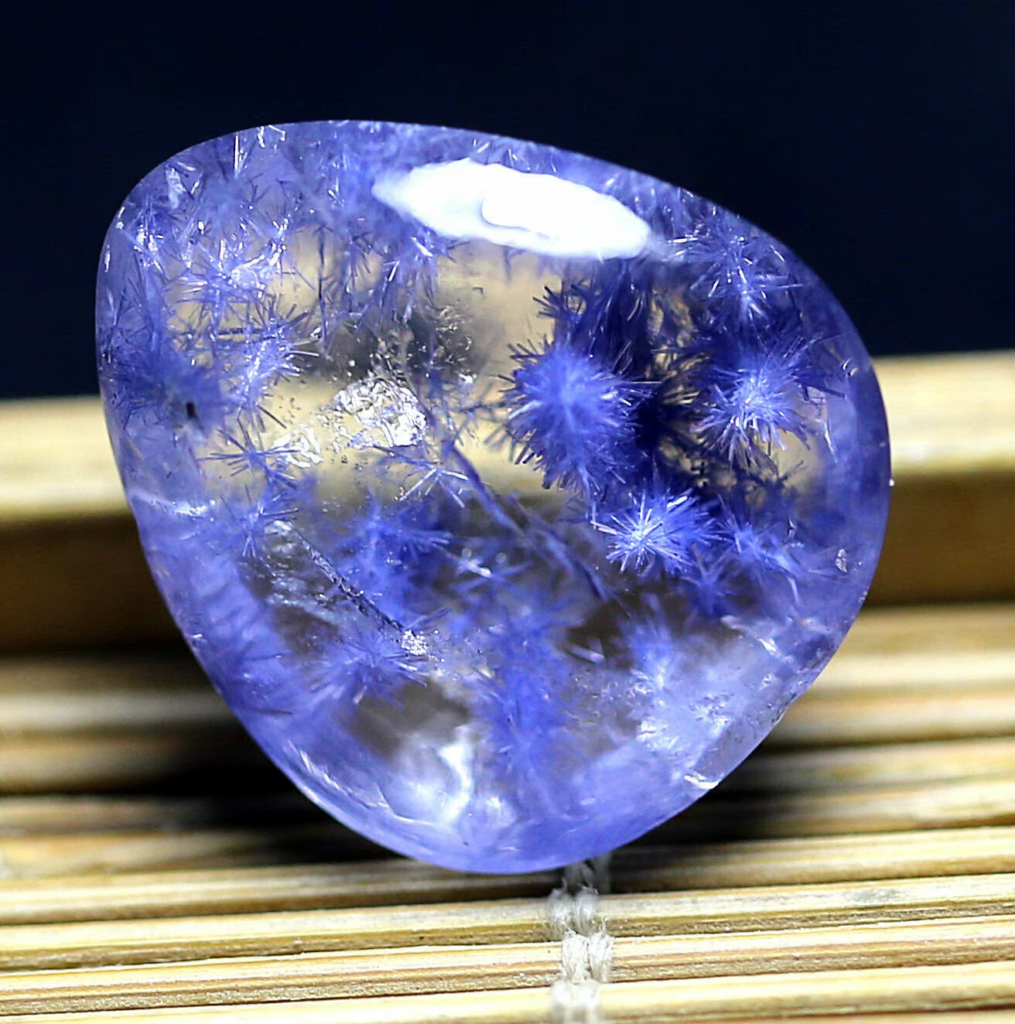
In terms of classification, dumortierite quartz falls under the category of “included quartz,” which refers to quartz crystals containing mineral or gas inclusions. Dumortierite is the specific mineral inclusion in this case. Quartz itself is a common mineral found in various geological environments, while dumortierite is less common and typically occurs in aluminum-rich metamorphic rocks.
Common colors of dumortierite quartz include shades of blue, ranging from light blue to deep violet-blue. The presence of dumortierite inclusions gives the quartz its distinctive coloration. The inclusions often appear as fine needle-like structures or wispy patterns within the quartz crystal.
Physically, dumortierite quartz shares many characteristics with other varieties of quartz. It has a hardness of 7 on the Mohs scale, making it durable and suitable for use in jewelry. Its crystal habit is typically hexagonal, with prismatic or tabular crystals. Dumortierite quartz often forms in hydrothermal veins, where hot fluids deposit minerals within rock fractures over long periods.
In addition to its aesthetic appeal, dumortierite quartz is believed to possess metaphysical properties. It’s associated with enhancing mental clarity, promoting self-discipline, and fostering a sense of calm and patience. Some people use dumortierite quartz in meditation practices or as a talisman for personal growth and focus.
Overall, dumortierite quartz is a fascinating variety of quartz that combines the beauty of quartz with the rarity of dumortierite, resulting in a gemstone prized for both its visual appeal and metaphysical attributes.
Geological Formation
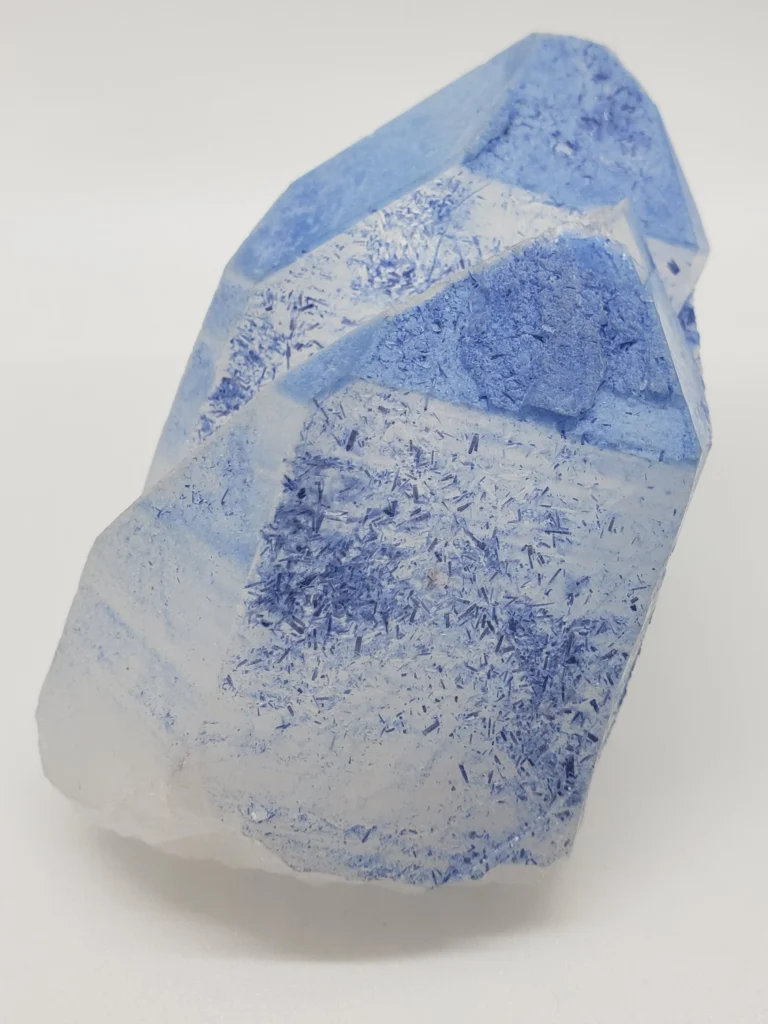
Dumortierite quartz typically forms through a process involving the incorporation of dumortierite mineral inclusions within quartz crystals. The exact formation process can vary depending on the geological environment, but it often involves hydrothermal activity and metamorphism.
Here’s a general overview of the formation process:
- Hydrothermal Activity: Dumortierite quartz often forms in hydrothermal environments where hot fluids rich in silica and other minerals circulate through fractures and voids in the surrounding rock. These fluids can dissolve minerals from the host rock and carry them along, depositing them elsewhere as the fluid cools and pressure decreases.
- Incorporation of Dumortierite: During the hydrothermal process, dumortierite minerals may be dissolved in the fluid along with silica. As the fluid encounters open spaces within quartz crystals, such as fractures or cavities, it deposits the dissolved minerals, including dumortierite, within the quartz matrix.
- Crystallization of Quartz: Quartz crystals continue to grow over time as silica-rich fluids deposit additional layers of quartz onto the existing crystals. As dumortierite is incorporated into the growing quartz crystals, it imparts its distinctive blue coloration, resulting in dumortierite quartz.
- Metamorphic Alteration: In some cases, the formation of dumortierite quartz may also involve metamorphic processes. Metamorphism occurs when rocks are subjected to high temperatures and pressures, causing changes in mineral composition and texture. Dumortierite itself is often associated with aluminum-rich metamorphic rocks. During metamorphism, pre-existing quartz crystals may incorporate dumortierite minerals present in the surrounding rock, leading to the formation of dumortierite quartz.
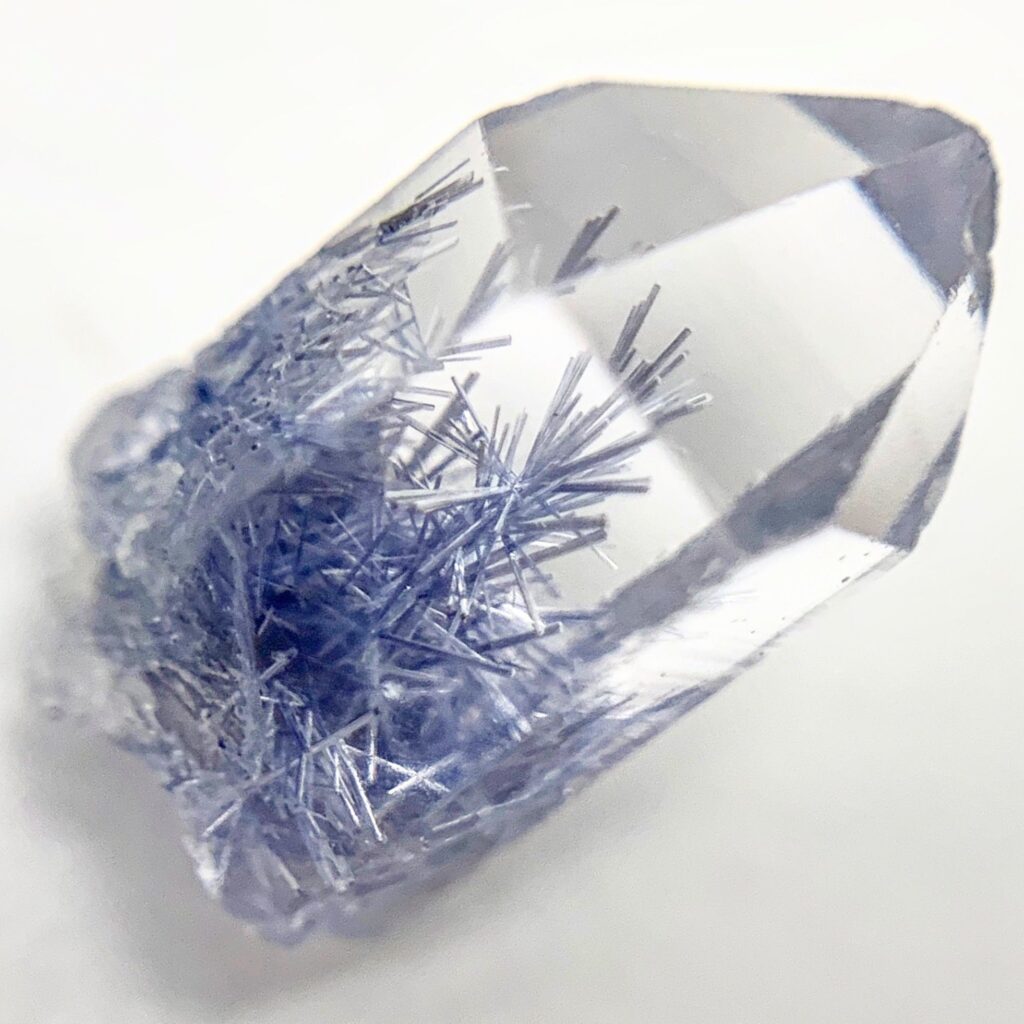
Typical geological environments where dumortierite quartz is found include:
- Quartz Veins: Dumortierite quartz is commonly found in quartz veins within metamorphic or igneous rocks. These veins form when silica-rich hydrothermal fluids deposit quartz and other minerals in fractures or faults within the host rock.
- Metamorphic Rocks: Dumortierite quartz is often associated with aluminum-rich metamorphic rocks such as schists and gneisses. These rocks undergo intense heat and pressure deep within the Earth’s crust, creating conditions favorable for the formation of dumortierite and its inclusion within quartz crystals.
- Pegmatites: Pegmatite veins, which are coarse-grained igneous rocks, can also contain dumortierite quartz. Pegmatites form from the crystallization of magma at high temperatures, and they often contain a variety of rare minerals, including dumortierite.
Overall, the formation of dumortierite quartz involves a complex interplay of geological processes, including hydrothermal activity, crystallization, and metamorphism, occurring within specific geological environments conducive to the deposition and growth of quartz crystals containing dumortierite inclusions.
Physical and Optical Properties

The physical and optical properties of dumortierite quartz are influenced by both the quartz matrix and the dumortierite inclusions. Here are the key properties:
- Hardness: Dumortierite quartz has a hardness of 7 on the Mohs scale, which is the same as pure quartz. This makes it relatively durable and resistant to scratching, suitable for use in jewelry and other ornamental purposes.
- Crystal Structure: Dumortierite quartz typically exhibits the hexagonal crystal structure characteristic of quartz minerals. The presence of dumortierite inclusions may not significantly alter the overall crystal structure of the quartz.
- Color: The most distinctive feature of dumortierite quartz is its blue to violet-blue coloration, which is imparted by the presence of dumortierite inclusions within the quartz matrix. The intensity and shade of blue can vary depending on factors such as the concentration of dumortierite and the presence of other impurities.
- Transparency: Dumortierite quartz is typically translucent to transparent, allowing light to pass through the crystal. The degree of transparency can vary depending on the size and distribution of dumortierite inclusions within the quartz.
- Luster: Dumortierite quartz often exhibits a vitreous luster, giving it a glassy and reflective appearance when polished. However, the presence of dumortierite inclusions may sometimes affect the luster, giving the crystal a slightly matte or silky sheen in certain areas.
- Optical Properties: Dumortierite quartz has similar optical properties to pure quartz. It has a refractive index of approximately 1.54 to 1.55, which means that light entering the crystal is bent or refracted as it passes through. Dumortierite inclusions may cause some dispersion of light, resulting in slight variations in refractive index within the crystal.
- Cleavage and Fracture: Dumortierite quartz typically lacks cleavage and exhibits a conchoidal fracture, meaning it breaks with smooth, curved surfaces. This fracture pattern is characteristic of quartz minerals and is not significantly affected by the presence of dumortierite inclusions.
Overall, dumortierite quartz combines the physical properties of quartz with the distinctive blue coloration imparted by dumortierite inclusions, resulting in a gemstone with unique aesthetic appeal and recognizable optical characteristics.
Sources and Locations
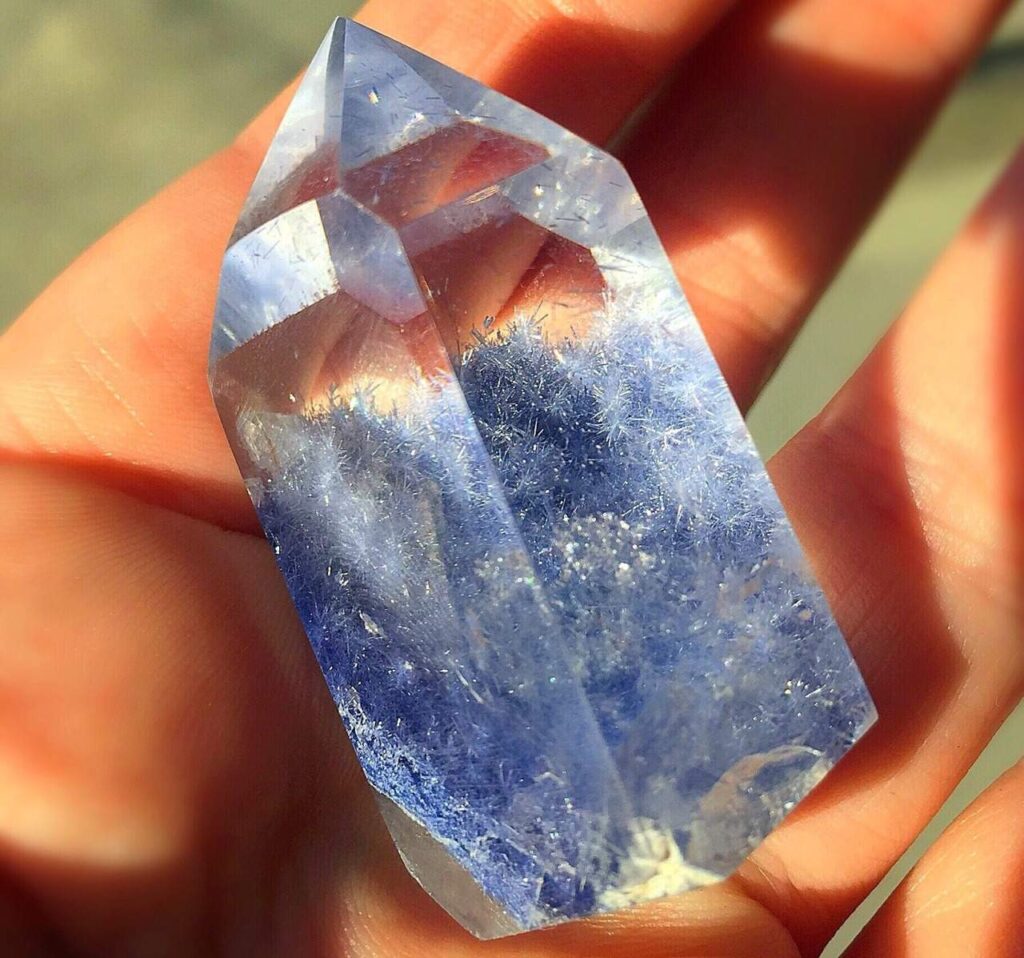
Dumortierite quartz is found in various locations around the world, typically in regions with geological conditions conducive to the formation of quartz veins and metamorphic rocks containing dumortierite. Some of the notable sources and locations where dumortierite quartz is found include:
- Brazil: Brazil is one of the primary sources of dumortierite quartz, particularly from the state of Minas Gerais. The region is known for its rich deposits of quartz crystals, often containing a variety of inclusions, including dumortierite.
- Namibia: Dumortierite quartz is also found in Namibia, particularly in the Erongo Region. The quartz crystals from this region often contain striking blue dumortierite inclusions, prized by collectors and lapidaries.
- Madagascar: Madagascar is another significant source of dumortierite quartz. Deposits are found in various regions across the island, including the Antananarivo Province. Madagascar produces a wide range of quartz crystals, including those with dumortierite inclusions.
- United States: Dumortierite quartz can be found in several locations throughout the United States, including California, Colorado, and Arizona. These regions have geological formations conducive to the formation of quartz veins and metamorphic rocks containing dumortierite.
- France: Dumortierite quartz has been found in certain regions of France, including the Auvergne-Rhône-Alpes region. French specimens often exhibit rich blue coloration and are sought after by collectors.
- Other Locations: Dumortierite quartz has also been reported from other countries, including Australia, Austria, Italy, and Russia. These occurrences may vary in terms of quantity and quality but contribute to the global supply of dumortierite quartz specimens.
Overall, dumortierite quartz is found in diverse geological settings worldwide, with each location offering unique specimens prized for their color, clarity, and other aesthetic qualities. Collectors and enthusiasts often seek out specimens from different sources to appreciate the variations in color and crystal morphology.
Uses of Dumortierite Quartz
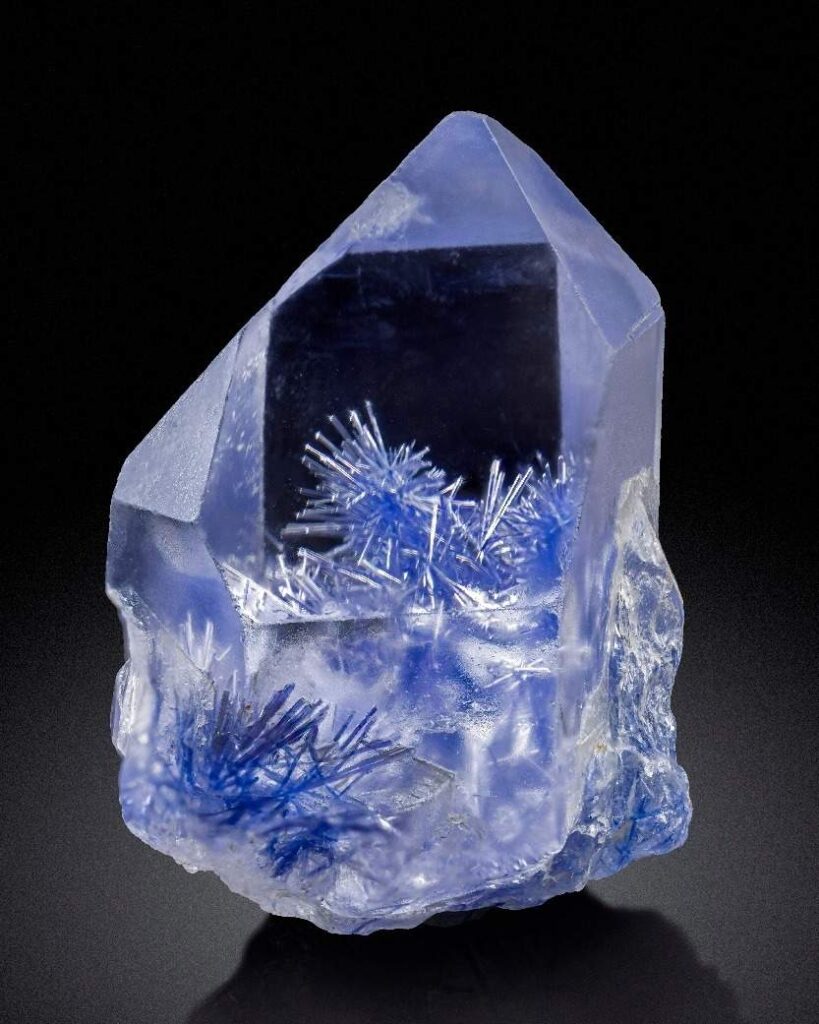
Dumortierite quartz, with its unique color and properties, has several uses and applications:
- Jewelry: One of the most common uses of dumortierite quartz is in jewelry making. Its striking blue coloration makes it a popular choice for gemstone jewelry, including earrings, pendants, rings, and bracelets. Dumortierite quartz can be cut and polished into various shapes and sizes, allowing for versatile designs in both traditional and contemporary jewelry styles.
- Collecting and Specimens: Dumortierite quartz is highly sought after by mineral collectors and enthusiasts due to its rarity and aesthetic appeal. Collectors often seek out specimens with well-defined crystals and vibrant blue coloration. Specimens may be displayed in mineral collections or used for educational purposes to study crystal morphology and mineral inclusions.
- Metaphysical and Healing Properties: Like other gemstones, dumortierite quartz is believed to possess metaphysical properties and healing qualities in certain spiritual practices. It’s associated with enhancing mental clarity, promoting self-discipline, and fostering a sense of calm and patience. Some people use dumortierite quartz in meditation practices or as a talisman for personal growth and focus.
- Ornamental Objects: Dumortierite quartz may also be used in the production of ornamental objects and decorative items. Its unique color and natural beauty make it a desirable material for sculptures, paperweights, and other artistic creations.
- Lapidary Purposes: Lapidaries and gemstone cutters may use dumortierite quartz as a material for cutting and faceting into gemstones. The durable nature of quartz and the striking blue coloration of dumortierite make it suitable for creating polished gemstones for use in jewelry or as collector’s items.
- Industrial Applications: In some cases, dumortierite quartz may have industrial applications. However, these are less common compared to its use in jewelry and lapidary arts. Its hardness and durability may make it suitable for certain abrasive and grinding applications, but such uses are relatively limited compared to other minerals.
Overall, dumortierite quartz finds a variety of uses ranging from jewelry and collecting to spiritual practices and artistic endeavors, thanks to its beautiful color, unique properties, and availability in nature.




































